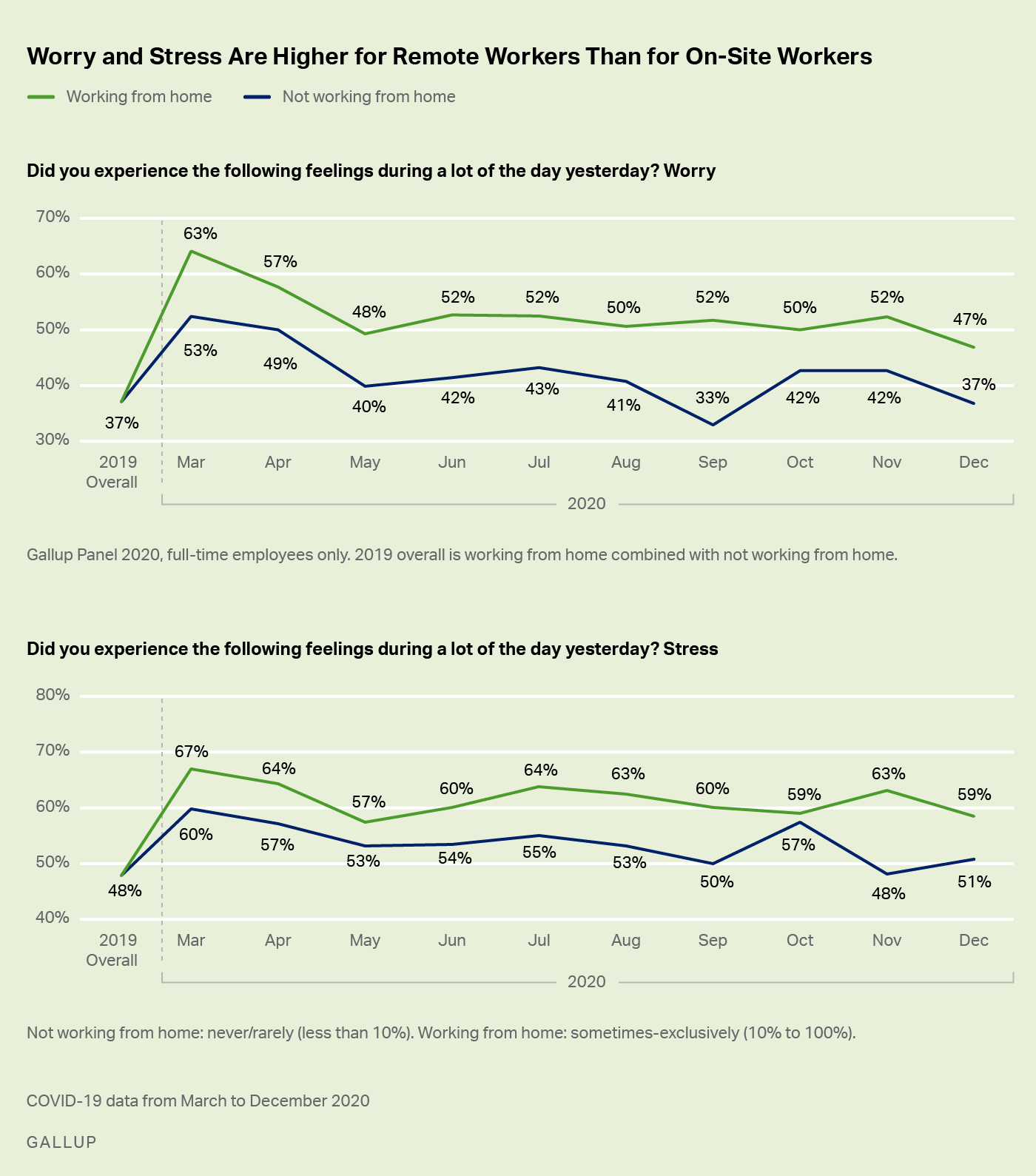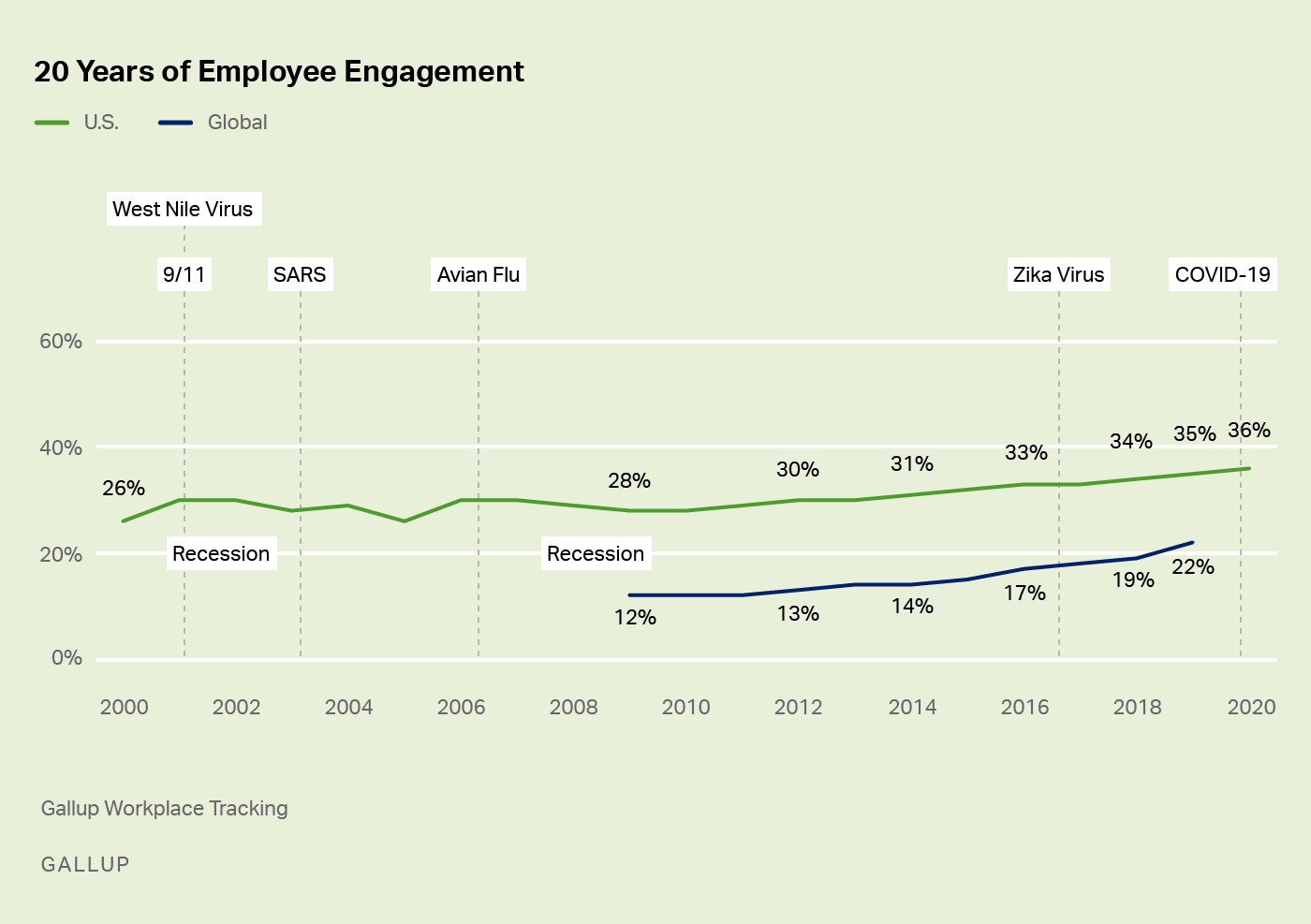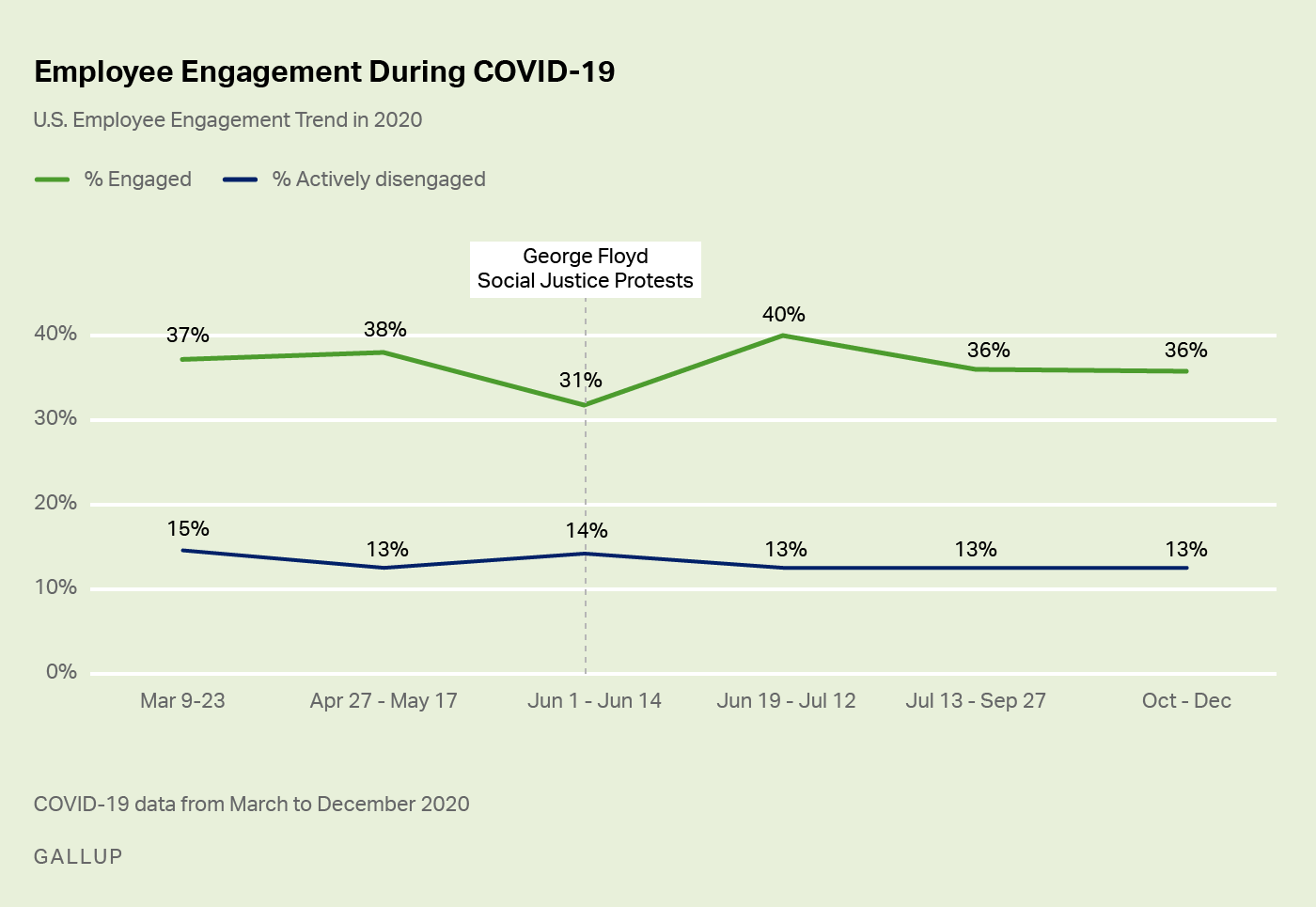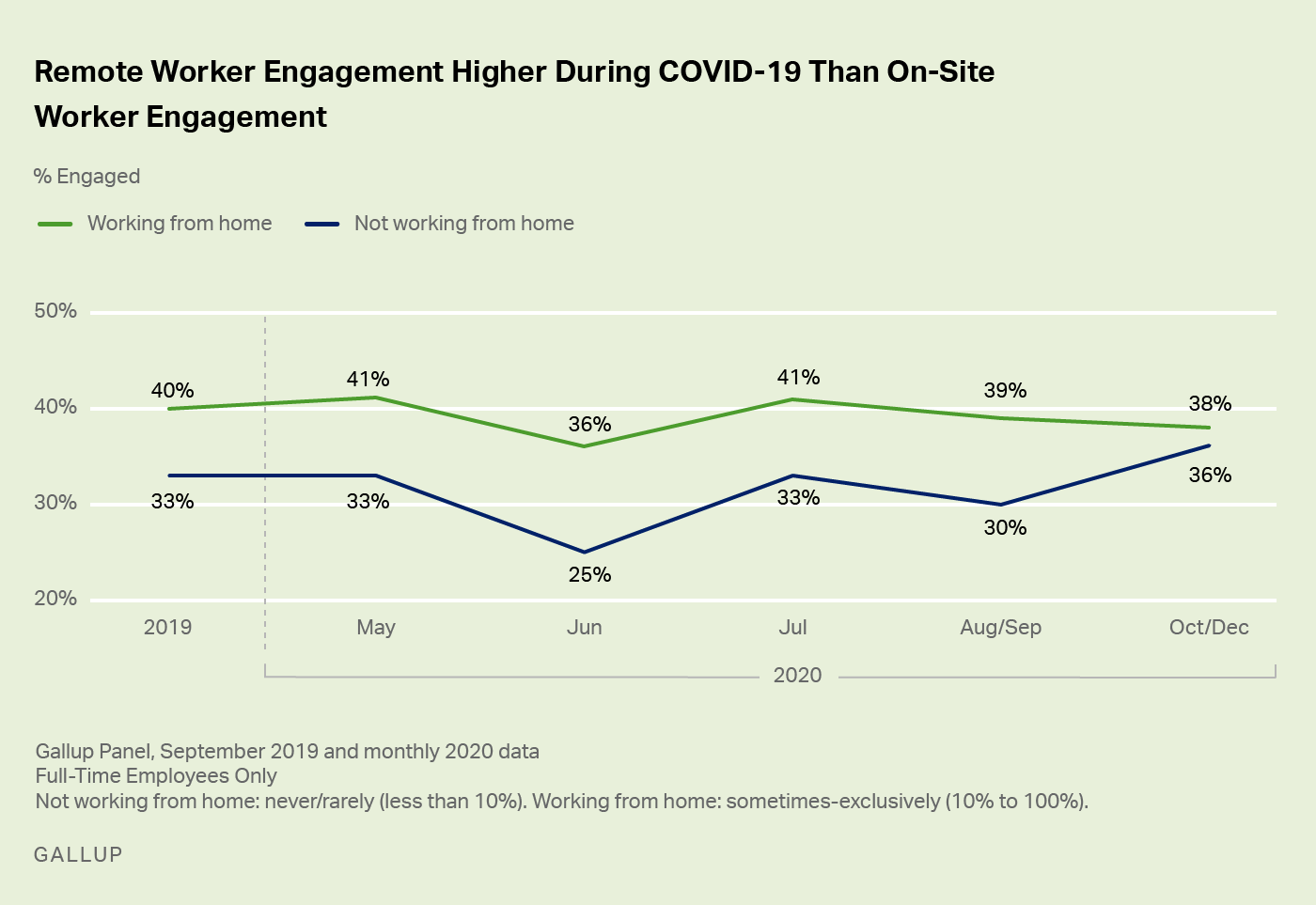Story Highlights
- Wellbeing and engagement diverged in 2020
- Remote workers experienced higher levels of engagement, stress, and worry
- Leaders face a crucial junction: sustainability and wellbeing vs. burnout
"Unprecedented" may be the most overused word of 2020, but COVID-19 workplace data trends are truly like nothing Gallup has ever seen. Gallup has been continuously tracking the engagement and wellbeing of the U.S. workforce since 2009 and increased frequency to nearly daily at the onset of the COVID-19 pandemic to better evaluate its impact. Many of our insights punctuate what most Americans are feeling every day, but some of the results may surprise you.
Among our most important discoveries is a trend we call the "Wellbeing-Engagement Paradox."
Typically, there's a link between employee engagement and wellbeing. Our research has shown that engagement and wellbeing are reciprocal -- each influences the future state of the other. They are also additive -- each makes a unique but complementary contribution to the thoughts, feelings, behaviors, and performance outcomes of employees. When they work together, they are a super-charger for a thriving, productive workplace. For instance, when employees are engaged and thriving at work, burnout decreases and productivity improves.
However, in 2020, employee engagement and wellbeing became disconnected from each other and went their own ways. This divergence presents critical implications for workplace leaders in the coming year.
Devastating Blows to Stress, Worry and Life Evaluation
People across the nation have experienced a significant decline in personal wellbeing due to COVID-19. Negative emotions, like stress and worry, spiked during the early months of the pandemic and sustained high levels continued to drain Americans' emotional fortitude. Even worse, Americans' life evaluations hit their lowest levels since the Great Recession of 2008 with only 46.5% of individuals evaluating their lives as "thriving" in April of 2020 -- a 15% drop from pre-pandemic levels. Common sources of pandemic-induced distress run the gamut from health and job concerns to social disconnectedness, social injustice, childcare strains, and uncertainty about the future.

Line graph depicting lowest level of thriving Americans since the Great Recession was reached during COVID-19.
Furthermore, stress and worry have been even worse for remote workers than on-site workers amid COVID-19 -- a great concern for employees and employers alike given that 40% to 60% of the U.S. workforce has been working remotely throughout 2020. As employers ponder offering long-term remote work opportunities and contemplate lingering questions about whether remote work affects productivity, the immediate need to support the wellbeing of their current remote workers continues to be a pressing concern.
Working from home during COVID-19 is associated with intensified levels of both engagement and negative emotions, like stress and worry.
These additional blows to the wellbeing of remote workers may not surprise those of you who are currently parenting, teaching and enduring extended workdays in a single space you have barely left since early 2020. And it's not just parents working from home who are experiencing exhaustion from the pandemic. Unmarried, fully remote workers are particularly susceptible to feelings of loneliness and isolation. Whether you're chasing kids around the house, spending more time with your roommate than you ever expected, or missing the company of others, there are plenty of unique pandemic-related challenges to go around.

Two vertically stacked line graphs comparing stress and worry levels between remote workers and on-site workers. In March 2020, both peaked at 67% of remote workers and 60% of on-site workers reporting feelings of stress, and 63% of remote workers and 53% of on-site workers reporting feelings of worry. Remote workers continued to report higher levels of stress and worry through December.
Fortunately, measures of wellbeing rebounded significantly since the early days of the pandemic, but life evaluations still trended at levels lower than normal, and stress and worry continued to be volatile through the ups and downs of 2020.
Looking forward, threats to wellbeing need to be closely monitored due to the impact they have on both individuals and society. In fact, historic drops in Gallup's life evaluation metric have preceded extreme social unrest and major economic events, such as Brexit, the Arab Uprisings, and the Euromaidan Revolution. It is quite possible that America's dip in thriving citizens may have even contributed to the social divisiveness experienced across the country in 2020.
The Resilience of Employee Engagement
Many expected employee engagement to plunge as a result of hardships caused by the pandemic.
Yet, in contrast to wellbeing, employee engagement maintained a better trajectory overall in 2020. It even reached a new record high multiple times throughout the summer before cooling off the rest of the year, and it closed at one percentage point higher than the 2019 average.

Line graph depicting a positive trajectory for U.S. and global employee engagement trends since 2000. In 2020, 36% of U.S. employees were engaged.
The fact that, overall, the national employee engagement average did not decline in 2020 really speaks to how the efforts, enthusiasm and commitment of many employees have been steadfast through COVID-19, despite experiencing a new kind of stress and worry each day. Employee engagement has been a life raft of sorts reflecting a range of positive experiences that have arisen from battling through the pandemic.
At a time when layoffs and furloughs abounded, employees were thankful to have jobs, experienced the benefits of increased flexibility and autonomy resulting from remote work, benefitted from strong leadership efforts to engage them, and rallied with coworkers to keep everything afloat. In short, employees were inspired by and united under a shared sense of purpose.
While the overall picture of engagement was relatively positive, compared with wellbeing, a closer look at the monthly data highlights some unusual short-term volatility during 2020. Typically, engagement is not affected by macro-level social or economic forces. But in 2020, we saw engagement spike to an all-time high in May before it dropped dramatically immediately after the killing of George Floyd and the ensuing social justice protests. Weeks later, June engagement ascended back up to a new record high with 40% of employees engaged in their jobs.
This flux in engagement is notable both for the historic events punctuating these trends and because it reflects the truly unprecedented times we're living in. We are navigating a constant state of new challenges while grappling with unknowns about the future.
We must also honor that some employees have been affected more adversely than others and the fact that only 36% of Americans were engaged at work in 2020 leaves much room for improvement.

Line graph depicting the fluctuations of U.S. employee engagement and disengagement in 2020. Engagement dropped from 38% to 31% after the killing of George Floyd, rose to 40% in early July, and settled back to 36% in October through December.
Now to answer the question that many organizations are asking with an eye to the future -- how did the forced experiment of working from home impact employee engagement?
In contrast to our wellbeing findings, remote workers have experienced significantly higher engagement than on-site workers for the majority of the pandemic.
This indicates that working from home during COVID-19 is associated with intensified levels of both engagement and negative emotions, like stress and worry. This is an important insight for leaders: When managing remote teams during the pandemic, leaders need to capitalize on the advantages of working from home, while actively working to reduce sources of exceptional stress and worry.
It is also important for leaders to remember that many employees were forced home with little warning and minimal guidance for how to structure their remote work effectively. Not to mention, many faced social isolation and restriction due to state and local regulations. Being unexpectedly trapped at home during a pandemic is a stark contrast to the flexibility and autonomy of choosing to work from home prior to the pandemic.

Line graph depicting the engagement of remote workers in the U.S. has fluctuated between 36% and 41%, while the engagement of on-site workers dipped as low as 25% in Jun (compared to 36% for remote workers).
Navigating the Engagement-Wellbeing Paradox
The resilience of employee engagement levels in 2020 was surprising given that wellbeing took such a hit and because, typically, there is a reciprocal relationship between the two. This paradox, however, begins to explain the extremely polarizing work-life experiences resulting from the pandemic.
So where does that leave us -- after engagement moved in one direction and wellbeing pulled in another direction for most of 2020?
Our biggest concern is that many employees have hit or are approaching a breaking point that leads to burnout and suffering with long-term consequences.
If organizations fail to engage employees and fend off chronically high levels of stress and worry, the result could adversely affect millions of lives. While we are seeing some early signs of improved wellbeing in 2021, we have a long road ahead to recovery and face new challenges associated with transitioning back to the workplace.
How employers and managers respond will make all the difference:
Leaders who work to proactively prevent and manage burnout, while capitalizing on the needed flexibility and efficiency that remote work affords, will be building stronger, healthier, more productive workforces into the future.
If left untreated, employee burnout has the potential to significantly impact those organizations and the lives of their employees.
Advice for Leaders: How to Help Employees Thrive Amid the Chaos
In light of our findings, Gallup recommends the following to lead away from burnout and toward a future-ready workplace:
- Start measuring employee wellbeing, in addition to engagement. Many organizations already have employee engagement surveys. Wellbeing needs to be added to the conversation. It may only require a few questions in a pulse survey, but it can help you highlight areas of concern that you can proactively address.
- Train managers to have conversations about wellbeing, above and beyond engagement. High engagement may be hiding red flags, as work-life balance vanishes. Managers must be able to have appropriate but caring conversations about life outside of work if they are going to manage performance effectively.
- Capitalize on the benefits of well-managed remote work. People who never worked from home before are enjoying greater flexibility with their jobs, which is beneficial to engagement. However, remote workers are also experiencing burnout more often during the pandemic. Managers need to be in-tune with employees' wellbeing while fostering work schedules that support productivity and work-life integration.
- Consider the disparate impact the pandemic is having on certain employees. For example, industries and sectors that employ significant numbers of women should be prepared for rising burnout, which undermines health and productivity. "Perks" to attract working mothers or single parents may now be table stakes for talent attraction and retention. Front-line workers may be experiencing steep financial hardships and people from various racial and ethnic backgrounds may be facing intensified diversity, equity and inclusion concerns. Employees need workplace cultures that are accepting and supportive of their heroic juggling act.
- Actively scan for signs of potential burnout. A "day off" may not be a sufficient fix in our current situation, when people need more managerial support and social connection rather than less. Managers should engage their teams, but not push them into overdrive. They are ultimately responsible for ensuring employees have realistic expectations, support and manageable workloads.
Get more analytics and advice on wellbeing and engagement:
- Read Working Remotely: Careers, Management and Strategy for details on the changing workplace and the experience of working from home amid the coronavirus.
- Partner with us to unpack and improve wellbeing and engagement in your organization.




